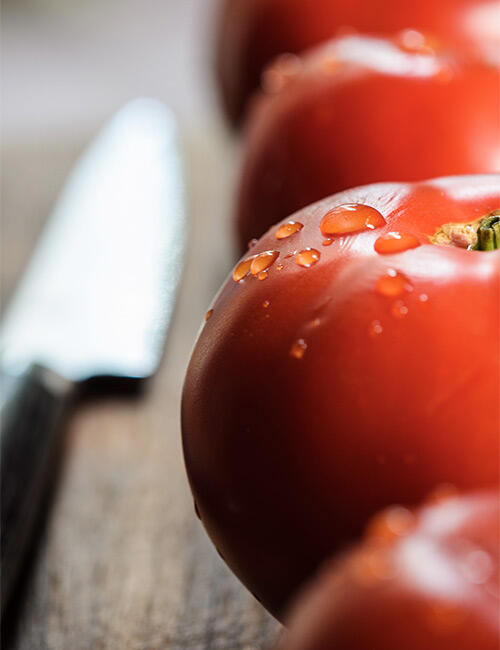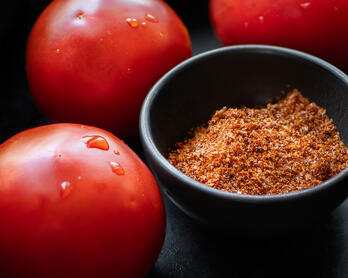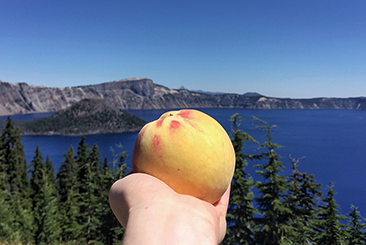Slow Roasted Tomatoes With Thyme and Garlic

If I had a Top 5 list of foods that I enjoy making and eating, slow roasted tomatoes would definitely be on it. The smell of thyme and tomatoes drifting from room to room for hours - it's summertime magic. So far this year, I've roasted Cherokee, beef, cherry, and Sun Gold and used them for everything from pizza toppings to sauce and avocado toast.
This recipe isn't complicated but since I plan to reference slow roasted tomatoes in the future, it seemed time to devote a post to my wrinkly favorites.
Useless Facts
There is a widely held belief that cooking your fruits and vegetables makes them less healthy by degrading the nutrients. Turns out that's not the case with tomatoes (sort of). Though roasting does decrease a tomato's vitamin C, it also significantly boosts the cancer-fighting compounds. What does this mean? It means that a piece of naturally leavened sourdough topped with roasted tomatoes, basil, avocado, and a drizzle of olive oil will give you superpowers. It's true. All of the sciencey nutrition details are here.


Cluster tomatoes at Peacock Family Farms - Santa Monica Farmers Market
Variables
Ripeness
If your tomatoes are super juicy, it's helpful to avoid overcrowding the baking sheet. The roasting time will take forever and a day because the tomatoes will be swimming in their juice. I put about 1 1/2 pounds of sliced tomatoes per sheet.
Oven Temperature
I've found recipes that call for 200 degrees all the way up to 400. The higher the temperature, the faster the outside will caramelize and the less time the pulp will have to release its juices and reduce. Higher temperatures aren't necessarily an issue depending on what you're using the tomatoes for (as mentioned below under "Use"). An article on NPR explained that, "You can do it fast, in which case it will be sludgy but luscious in the middle, with a slippery, detachable outside. Or you can do it slowly, in which case the texture will be more cohesive, uniformly tacky, and chewy." Basically, "lower and slower" mean less moisture and more flavor. I usually roast at 350 but will probably experiment with reduced temperatures this season.
Use
The amount of time it takes to roast the tomatoes depends on how concentrated you want flavor. If I'm roasting for sauce (in which case the tomatoes will be puréed), I go all out until the edges are chewy and deeply caramelized which takes 2+ hours. If I'm using the tomatoes as a topping, I sometimes pull the time back. The tried-and-true way to know when the tomatoes are done to your liking is to take a taste. If you decide to go with a lower oven temperature, the roasting time will be considerably longer (two or three times) than I'm quoting.
Tools
- Baking Sheet
- Aluminum Foil
- Parchment Paper
Ingredients
- 3 lbs of ripe tomatoes, sliced Note: This recipe works great with cherry tomatoes. Reduce the olive oil accordingly.
- 1/2 cup + 2 tbsp olive oil (5 tbsp per baking sheet) Note: The infused olive oil that you end up with is absolutely wonderful. Drizzle it on avocado toast, make a salad dressing, or just mix it in with whatever sauce you're making. Yum.
- 6 smashed garlic cloves (3 per baking sheet)
- 1 bunch of thyme, left whole
- Flake-style salt and freshly ground pepper

A note about this apron at the bottom.
Instructions
- Move your oven racks to the middle and lower-middle positions and heat to 350.
- Line each baking sheet with aluminum foil and then lay a piece of parchment paper on top of that.
- Arrange the tomato slices in a single layer, about 1 1/2 lbs per baking sheet.
- Add 3 garlic cloves to each pan.
- Drizzle 5 tbsp of olive oil over each sheet, gently turning and moving the tomatoes around so they're evenly covered.
- Sprinkle with flake-style salt and freshly ground pepper. Note: The salt is a flavor component and also helps break down the tomatoes.
- Pour a little olive oil on the thyme to moisten, then scatter the stems (whole) over each baking sheet. Note: The thyme will completely dry out at the end of roasting so just let the stems sit on top. Makes them easier to discard.
- Roast the tomatoes for 1 1/2 - 2 hours, rotating the baking sheets from top to bottom and front to back at least once. Note: I find the tomatoes on the lower rack roast a lot faster so keep an eye on them.
- Discard the thyme.
- Transfer tomatoes and all of the oils to a airtight container, cool, then refrigerate. Note: I refrigerate the tomatoes for a day before freezing to ensure proper cooling. Not sure if this step is necessary but it seems logical to me so that's what I do. Chef's discretion.
Storage
The roasted tomatoes can be frozen for an extended period of time or refrigerated in an airtight container for 2-3 days.
Apron Note
Rob and I bought my Slow Food apron while we were on our honeymoon in Italy. For a little background, the Slow Food movement began in that country about thirty years ago and it is now a global endeavor. The organization's aim is to protect, preserve, and promote artisanal and regional food around the world.
Back then, I didn't realize what a big part of my life food would become or how committed I would be to local artisans and producers. I just liked the concept of "Slow Food" and thought the snails on the apron were cute. Needless to say, I love wearing it in the kitchen, and when I'm sitting at the dining room table...and really I'd wear it out of the house to run errands. Aprons are the new leopard flats.
In my previous post, I talked about caciocavallo cheese and Slow Food's Presidia Project. If that doesn't interest you, the post also includes pizza inspiration. Pizza is always a good idea.






